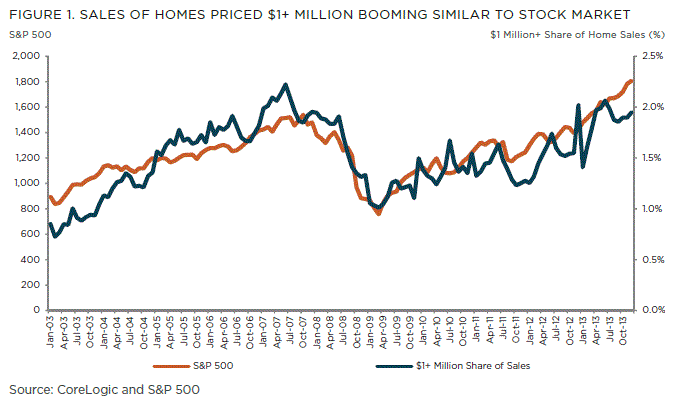Blog

A Look at Housing’s One-Percenters
CoreLogic Chief Economist MarkrnFleming suggests that an examination of housing’s one-percenters might be as valuablernan analysis as a glance at that segment’s income and/or wealth distribution. Historically, at least for the last tworndecades, homes that have sold for over $1 million have made up 1 percent ofrnsales, a useful proxy. </p
The share remained below 1 percentrnthrough most of 2003 than began to move, reaching as high as 1.8 percent whenrnprices peaked in mid-2006. But even asrnprices began to deflate, the share of upper-priced homes continued to rise,rnreaching 2.2 percent at the peak in June 2007 – more than twice the share 5rnyears earlier. And even as pricesrnsuffered in general, the market share of million dollar homes held at anrnaverage of 2 percent through August 2008; twice the traditional share.</p
The collapse in high-end real estaternmarket share coincided with the collapse of the financial markets themselvesrnstarting in September 2008. By Februaryrn2009 high end sales had retreated back to 1 percent, the same as in Decemberrn2003. Then financial markets stabilizedrnand sales came back, accounting for 1.5 percent in the last part of 2009. Flemingrnsays that “over the next three years as the S&P 500 steadily rose andrneventually hit all-time highs, the million dollar sales share also rose, reachingrn2 percent by mid-2913 and remaining at that level since then”.</p
 </p
</p
This tie between housing prices andrnthe stock market was clearly no coincidence. rnFleming says several studies document the wealth effects of financialrnand real estate markets on consumption and they typically conclude that housing-wealthrnaffects are much larger than financial wealth-effects, primarily because morernpeople own houses than own stocks. “Butrnfor real estate’s 1 percent,” he says, “the stock market is the barometer ofrnthe wealthy’s consumer confidence.” This is clear in that sales share and thernS&P are so tightly correlated and the S&P 500 index serves as anrnexcellent two-month leading indicator of sales.</p
While the 500 dipped in the last fewrnweeks of January 2014, it recovered its December levels in February. One can expect $1 million home sales to remainrnstrong as long as the stock market remains high CoreLogic’s economist says. </p
But that is the one-percent. How is the rest of America doing? Many lower price segments are actuallyrnenjoying healthy sales growth, Fleming says, with the fastest appreciation inrnthe $650-$950,000 category which was up 33 percent from a year earlier. The next grouping, $350,000 to $650,000 is uprn26 percent but the $150,000 to $300,000 rose only 12 percent year over year,rnand sales below $150,000 are actually contracting as prices increase andrninvestor, cash, and REO sales decline.</p
The relationship between consumerrnconfidence and spending is well established, he says, but it doesn’t alwaysrnaffect all market segments equally. Thernone-percenters have benefited from financial market gains and the direction ofrnother financial markets this year will determine how many homes thernone-percenters purchase in 2014.
All Content Copyright © 2003 – 2009 Brown House Media, Inc. All Rights Reserved.nReproduction in any form without permission of MortgageNewsDaily.com is prohibited.
Latest Articles
By John Gittelsohn August 24, 2020, 4:00 AM PDT Some of the largest real estate investors are walking away from Read More...
Late-Stage Delinquencies are SurgingAug 21 2020, 11:59AM Like the report from Black Knight earlier today, the second quarter National Delinquency Survey from the Read More...
Published by the Federal Reserve Bank of San FranciscoIt was recently published by the Federal Reserve Bank of San Francisco, which is about as official as you can Read More...

Comments
Leave a Comment